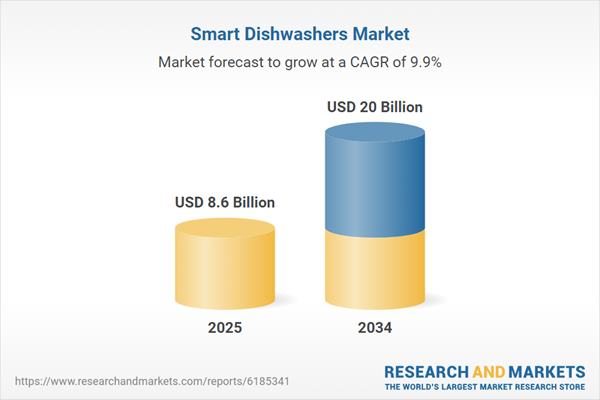The smart dishwashers market is rapidly evolving as part of the broader smart home ecosystem, appealing to consumers seeking convenience, energy efficiency, and connected living. These next-generation dishwashers integrate Wi-Fi or Bluetooth connectivity, allowing users to control and monitor their appliances remotely through smartphone apps or voice assistants like Alexa and Google Assistant. Features such as cycle customization, detergent level tracking, water usage optimization, and self-diagnostics not only simplify the dishwashing process but also help households reduce energy and water consumption. As lifestyles grow increasingly busy and sustainability becomes a purchasing priority, smart dishwashers are emerging as a favored appliance in both urban apartments and modern family homes. The market is being driven by advances in home automation, growing consumer awareness of environmental impact, and the desire for appliances that offer personalized control and efficiency. Premium kitchen renovation trends and the rising penetration of smart kitchen ecosystems are further accelerating adoption across North America, Europe, and rapidly urbanizing Asian markets.
The smart dishwashers market saw significant developments in design innovation, user interactivity, and market reach. Manufacturers introduced AI-driven dishwashers capable of learning household habits and suggesting optimal wash cycles based on load composition and usage patterns. New models emphasized eco-conscious features like low-noise operations, enhanced energy ratings, and automatic load-sensing capabilities. Leading brands launched app updates that integrated smart dishwashers with kitchen planning platforms, recipe management tools, and even grocery lists based on dish usage trends. Voice-activated functions became more sophisticated, allowing users to check cycle status, reorder detergent, or receive maintenance alerts without lifting a finger. Sustainability-focused consumers gravitated toward dishwashers with built-in water recycling systems, and several manufacturers began using recyclable components in their construction. E-commerce channels, particularly in Asia-Pacific, expanded accessibility by offering smart dishwashers bundled with other connected appliances. Partnerships between tech companies and appliance manufacturers further enriched the user experience with smoother ecosystem integration, enabling dishwashers to communicate with other devices like smart ovens and fridges in a cohesive home automation framework.
The smart dishwashers market is expected to shift toward greater personalization, predictive maintenance, and environmental accountability. Future models will likely feature embedded sensors capable of detecting food residue levels and adjusting wash intensity in real-time. AI will play a larger role in optimizing water, heat, and detergent usage based on learned patterns. Smart dishwashers will be integrated with broader sustainability dashboards in homes, allowing users to monitor and manage their water and energy footprints. As edge computing becomes more accessible, devices will make local decisions without relying heavily on cloud processing, improving response times and data privacy. Manufacturers will increasingly incorporate recycled plastics and modular designs to meet circular economy standards. In emerging economies, more affordable smart dishwasher models will enter the market, aided by government incentives for water-saving appliances. However, affordability and consumer education remain key challenges, especially for first-time users unfamiliar with connected appliance ecosystems. The long-term success of the market will depend on delivering not just innovation, but also tangible everyday benefits like lower bills, fewer breakdowns, and a cleaner, more efficient kitchen.
Key Insights: Smart Dishwashers Market
- AI-Powered Load Recognition and Cycle Customization: Dishwashers are increasingly using AI and machine learning to detect load type and soil levels, automatically selecting the most efficient wash cycle for optimal cleaning and resource savings.
- Integration with Voice Assistants and Home Ecosystems: Smart dishwashers now support hands-free operation via Alexa, Google Assistant, and smart hubs, allowing users to control wash cycles, check status, and receive maintenance alerts with voice commands.
- Growth of Water- and Energy-Saving Features: Eco-focused consumers are demanding dishwashers with smart sensors that optimize water and energy usage, contributing to sustainability goals while lowering household utility bills.
- Modular and Sustainable Product Design: Leading manufacturers are designing smart dishwashers with recyclable parts, modular components, and extended product lifecycles to meet environmental regulations and consumer demand for green appliances.
- Cross-Platform App Integration and Analytics: Smart dishwasher apps are evolving to include personalized usage reports, detergent tracking, cycle reminders, and integration with other smart kitchen appliances for a seamless user experience.
- Rising Adoption of Smart Home Appliances: Increasing consumer preference for connected living and remote control capabilities is boosting demand for dishwashers that can integrate with broader home automation systems.
- Growing Emphasis on Energy and Water Efficiency: Environmental awareness and government regulations are encouraging consumers to switch to appliances that help reduce water and electricity consumption without sacrificing performance.
- Demand for Convenience and Time Savings: Busy lifestyles are prompting households to invest in smart dishwashers that offer real-time alerts, remote operation, and intelligent wash programs, reducing manual effort and enhancing convenience.
- Technological Advancements and Competitive Innovation: Continuous R&D investments by manufacturers are leading to more intelligent, user-friendly, and feature-rich dishwasher models, expanding market appeal and encouraging upgrades from traditional models.
- High Cost and Limited Awareness in Developing Markets: Despite growing interest, the high initial cost of smart dishwashers and lack of awareness about their long-term benefits are hindering adoption in price-sensitive and rural areas of emerging economies.
Smart Dishwashers Market Segmentation
By Type
- Small Size Freestyle Smart Dishwashers
- Large-Scale Freestyle Smart Dishwashers
By Distribution Channel
- Offline
- Online
By Applications
- Household
- Commercial
Key Companies Analysed
- Samsung Electronics Co Ltd.
- BSH Hausgeräte GmbH
- GE Appliances
- Whirlpool Corporation
- LG Electronics Inc.
- Electrolux AB
- Miele & Cie. KG
- Robert Bosch GmbH
- Panasonic Corporation
- Haier Group Corporation
- Aga Rangemaster Group
- Asko Appliances AB
- Dacor Inc.
- Fagor America Inc.
- Hoover Candy Group
- SR Brands LLC
- SMEG SpA
- VESTEL Group
- Xiaomi Corporation
- Maytag Corporation
- Café Appliances
- KitchenAid
- Frigidaire Appliances
- Inter IKEA Systems BV
- Kenmore
- Thermador
- JennAir
- Fisher & Paykel Appliances Holdings Ltd.
- Blomberg Appliances
- Hisense
Smart Dishwashers Market Analytics
The report employs rigorous tools, including Porter’s Five Forces, value chain mapping, and scenario-based modeling, to assess supply-demand dynamics. Cross-sector influences from parent, derived, and substitute markets are evaluated to identify risks and opportunities. Trade and pricing analytics provide an up-to-date view of international flows, including leading exporters, importers, and regional price trends.Macroeconomic indicators, policy frameworks such as carbon pricing and energy security strategies, and evolving consumer behavior are considered in forecasting scenarios. Recent deal flows, partnerships, and technology innovations are incorporated to assess their impact on future market performance.
Smart Dishwashers Market Competitive Intelligence
The competitive landscape is mapped through proprietary frameworks, profiling leading companies with details on business models, product portfolios, financial performance, and strategic initiatives. Key developments such as mergers & acquisitions, technology collaborations, investment inflows, and regional expansions are analyzed for their competitive impact. The report also identifies emerging players and innovative startups contributing to market disruption.Regional insights highlight the most promising investment destinations, regulatory landscapes, and evolving partnerships across energy and industrial corridors.
Countries Covered
- North America - Smart Dishwashers market data and outlook to 2034
- United States
- Canada
- Mexico
- Europe - Smart Dishwashers market data and outlook to 2034
- Germany
- United Kingdom
- France
- Italy
- Spain
- BeNeLux
- Russia
- Sweden
- Asia-Pacific - Smart Dishwashers market data and outlook to 2034
- China
- Japan
- India
- South Korea
- Australia
- Indonesia
- Malaysia
- Vietnam
- Middle East and Africa - Smart Dishwashers market data and outlook to 2034
- Saudi Arabia
- South Africa
- Iran
- UAE
- Egypt
- South and Central America - Smart Dishwashers market data and outlook to 2034
- Brazil
- Argentina
- Chile
- Peru
Research Methodology
This study combines primary inputs from industry experts across the Smart Dishwashers value chain with secondary data from associations, government publications, trade databases, and company disclosures. Proprietary modeling techniques, including data triangulation, statistical correlation, and scenario planning, are applied to deliver reliable market sizing and forecasting.Key Questions Addressed
- What is the current and forecast market size of the Smart Dishwashers industry at global, regional, and country levels?
- Which types, applications, and technologies present the highest growth potential?
- How are supply chains adapting to geopolitical and economic shocks?
- What role do policy frameworks, trade flows, and sustainability targets play in shaping demand?
- Who are the leading players, and how are their strategies evolving in the face of global uncertainty?
- Which regional “hotspots” and customer segments will outpace the market, and what go-to-market and partnership models best support entry and expansion?
- Where are the most investable opportunities - across technology roadmaps, sustainability-linked innovation, and M&A - and what is the best segment to invest over the next 3-5 years?
Your Key Takeaways from the Smart Dishwashers Market Report
- Global Smart Dishwashers market size and growth projections (CAGR), 2024-2034
- Impact of Russia-Ukraine, Israel-Palestine, and Hamas conflicts on Smart Dishwashers trade, costs, and supply chains
- Smart Dishwashers market size, share, and outlook across 5 regions and 27 countries, 2023-2034
- Smart Dishwashers market size, CAGR, and market share of key products, applications, and end-user verticals, 2023-2034
- Short- and long-term Smart Dishwashers market trends, drivers, restraints, and opportunities
- Porter’s Five Forces analysis, technological developments, and Smart Dishwashers supply chain analysis
- Smart Dishwashers trade analysis, Smart Dishwashers market price analysis, and Smart Dishwashers supply/demand dynamics
- Profiles of 5 leading companies - overview, key strategies, financials, and products
- Latest Smart Dishwashers market news and developments
Additional Support
With the purchase of this report, you will receive:- An updated PDF report and an MS Excel data workbook containing all market tables and figures for easy analysis.
- 7-day post-sale analyst support for clarifications and in-scope supplementary data, ensuring the deliverable aligns precisely with your requirements.
- Complimentary report update to incorporate the latest available data and the impact of recent market developments.
This product will be delivered within 1-3 business days.
Table of Contents
Companies Mentioned
- Samsung Electronics Co Ltd.
- BSH Hausgeräte GmbH
- GE Appliances
- Whirlpool Corporation
- LG Electronics Inc.
- Electrolux AB
- Miele & Cie. KG
- Robert Bosch GmbH
- Panasonic Corporation
- Haier Group Corporation
- Aga Rangemaster Group
- Asko Appliances AB
- Dacor Inc.
- Fagor America Inc.
- Hoover Candy Group
- SR Brands LLC
- SMEG SpA
- VESTEL Group
- Xiaomi Corporation
- Maytag Corporation
- Café Appliances
- KitchenAid
- Frigidaire Appliances
- Inter IKEA Systems BV
- Kenmore
- Thermador
- JennAir
- Fisher & Paykel Appliances Holdings Ltd.
- Blomberg Appliances
- Hisense
Table Information
| Report Attribute | Details |
|---|---|
| No. of Pages | 160 |
| Published | October 2025 |
| Forecast Period | 2025 - 2034 |
| Estimated Market Value ( USD | $ 8.6 Billion |
| Forecasted Market Value ( USD | $ 20 Billion |
| Compound Annual Growth Rate | 9.8% |
| Regions Covered | Global |
| No. of Companies Mentioned | 30 |









